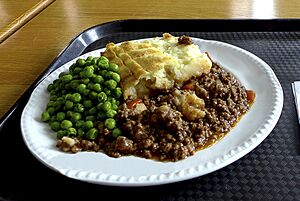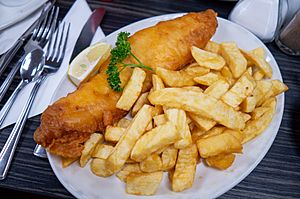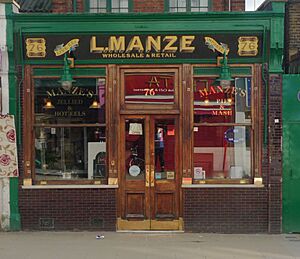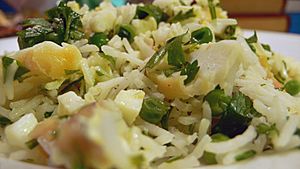British cuisine facts for kids
British cuisine is all about the cooking traditions and practices found across the United Kingdom. This includes the unique foods of England, Scotland, Wales, and Northern Ireland. Historically, British food was known for using fresh, local ingredients. It focused on simple dishes with sauces that made the flavors stand out.
For a long time, British food was mostly known worldwide for the full breakfast and Christmas dinner. But ancient people in Britain, called Celts, were already growing many different foods and raising animals. Later, the Normans brought new things like wine and words for meats like beef and mutton. The Anglo-Saxons developed ways to stew meat and herbs. During the Middle Ages, the Normans also introduced exciting spices to Britain.
Over thousands of years, many new foods arrived in Britain. Sausages came with the Romans. Rice, sugar, oranges, and spices from Asia arrived in the Middle Ages. After 1492, the Columbian exchange brought new foods like beans and potatoes from the Americas. Spicy curry sauces from India became popular in the 1700s and 1800s. Even common vegetables today, like cabbage, peas, and cherries, were brought by the Romans.
Some classic British dishes include the full breakfast, roast dinner, fish and chips, toad in the hole, and shepherd's pie. For desserts, there's trifle, scones, apple pie, sticky toffee pudding, and Victoria sponge cake. Did you know that Cheddar cheese comes from a village called Cheddar in Somerset? Today, British cooking is influenced by foods from all over the world. It has also influenced other cultures' cuisines.
The popular sandwich is named after John Montagu, 4th Earl of Sandwich. He is said to have invented it!
Contents
History of British Food
Early Beginnings
People in Britain started making bread from different grains around 3700 BC. That's a very long time ago!
Cider is an old British drink. The first time cider was mentioned was when Julius Caesar tried to invade Britain in 55 BC. He found the native Celts making a fermented drink from crabapples. He took this idea back to Europe with his soldiers.
During Roman times, more foods were introduced. These included sausages, rabbit, and herbs like chives and coriander. Wine was also brought in and even made in Britain, as far north as Northamptonshire.
After the Romans left and before the Norman conquest in 1066, British food was mostly vegetables, grains, and mutton. The Anglo-Saxons brought bacon to Britain. Since then, English people have raised pigs for bacon. Each family used to have their own secret recipe for curing and smoking bacon.
Bread and butter became common for many people. The English were known for using a lot of melted butter as a sauce with their meat and vegetables.
The Norman conquest in the Middle Ages brought back spices and European influences. Oranges arrived in the late 1200s, sugar cane in the 1300s, and carrots in the 1400s.
From New Worlds to New Dishes
When Europeans explored the Americas after 1492, many new foods came to Europe. This was called the Columbian exchange. It brought us refined sugar, the potato, the banana, and chocolate. Global trade also brought foods and drinks from other parts of the world, like tea and coffee. New ways of growing plants also led to many more types of fruits and vegetables.
The turkey arrived in Britain in the 1500s. But it only became a popular choice for Christmas dinner in the 1800s, usually served with Christmas pudding. Other traditional British dishes, like fish and chips and the full breakfast, became very popular during the Victorian era (1837-1901).
The world's first sweet-tasting pea was created in the 1700s by Thomas Edward Knight in England. Before the Industrial Revolution, bacon was usually made on farms or in homes. The first commercial bacon processing plant opened in Wiltshire in the 1770s.
Food in the 20th Century

During the World Wars in the 1900s, it was hard to get enough food. So, the government introduced rationing. This meant people could only buy a limited amount of certain foods. Rationing continued for almost ten years after the Second World War. This meant a whole generation grew up without many common ingredients. Some people think this made British cooking less exciting for a while.
By the 1960s, more people started going on holidays abroad. Also, more restaurants serving foreign foods opened in Britain. This made foreign cuisines much more popular. Famous chefs on TV and in cookbooks, like Delia Smith and Jamie Oliver, also helped people try new things.
From the 1970s, it became easier to find a wider range of good quality fresh foods. People in Britain also became more open to trying different diets. Modern British cooking now uses ideas from Mediterranean (especially Italian cuisine), Middle Eastern, and Asian foods. In the 1990s, a new idea emerged: British cuisine could mix and match influences from other cultures.
Also from the 1970s, there was a push to celebrate British cuisine. The English Tourist Board encouraged restaurants to offer more traditional British dishes. In the 1980s, a style called "Modern British Cooking" appeared. This style focused on fresh garden vegetables and aimed to create a national cuisine for tourists.
Anglo-Indian Cuisine
In the 1700s and 1800s, the British Empire was influenced by India's rich food traditions. Indian spices and herbs started to appear in British cooking. This led to new dishes like kedgeree (from 1790) and mulligatawny soup (from 1791).
Curry became very popular in Britain by the 1970s. Many restaurants that first served mainly Indian people started to attract a wider range of customers. Chicken tikka masala, a mild curry with a creamy sauce, has even been called "a true British national dish." This shows how Britain takes ideas from other cultures and makes them its own.
Food in the 21st Century
In the 21st century, food standards and tastes have kept changing. Some experts say that British dining now rivals that of France.
A survey in 2021 found that many people had never eaten traditional foods like toad in the hole, spotted dick, Scotch eggs, black pudding, or bubble and squeak. Some even thought these dishes weren't real!
Another survey in 2021 showed that 8% of people were eating a plant-based diet. More than a third were interested in becoming vegan. In 2023, government numbers showed that people in Britain were eating the least meat at home since records began in 1974.
Recently, there's been a growing effort to bring back traditional British bread-making. Chef Michel Roux Jr. has talked about how important it is to return to old methods. He wants people to make bread with simple, natural ingredients. He also encourages supporting local, independent bakeries. He hopes this will help keep this valuable food tradition alive.
What Makes British Food Special?
British food is often seen as a mix of different cultures. It takes ideas from its own history and from other countries. This creates a unique blend of flavors.
Internationally, British food sometimes has a reputation for being "terrible." People might think it's bland or overcooked. One reason for this idea is that British food traditions were strong before the mid-1900s. But then, wartime rationing made it hard to get good ingredients. Many myths about British food come from this time.
Popular British Dishes
According to a survey, the most popular British food is Yorkshire pudding. Over 85% of British people say they like it! Sunday roasts and fish and chips are also very popular. The least popular was jellied eels. Only 6% of those who tried it liked it. For sweet foods, scones and Victoria sponge are favorites. The Deep-fried Mars bar is the least popular sweet treat.
The Full English Breakfast was voted the most popular British dish in late 2023. With an 87% popularity rate, it's considered the national dish of the UK.
Curries are a big part of British cuisine. Cooks in the UK have created their own unique curries. Chicken tikka masala makes up 15% of orders in British Indian restaurants. In 2001, a government official called it "a true British national dish." Generally, British curries are thicker and sweeter than Indian ones. A key ingredient in British curry is curry powder, which is a British mix of spices.
National Cuisines of the UK
English Cuisine
English cuisine has its own special qualities. But it also shares a lot with the wider British food scene. This is partly because of ingredients and ideas brought from North America, China, and India during the time of the British Empire. Also, after World War II, many people from other countries moved to the UK. Some old English meals, like sausages, bread, cheese, roasted meats, meat and game pies, boiled vegetables, and fish, have very old roots. A cookbook from the 1300s, called the Forme of Cury, has recipes for these dishes.
Northern Irish Cuisine
Northern Ireland's food history comes from the simple diet of farming families: bread and potatoes. For a long time, it was hard to get many different ingredients. Also, not many people moved there from other countries. This meant their food didn't change much. But in the 21st century, local food has gotten much better. There are now more and better gastropubs and restaurants. Northern Ireland even has three restaurants with Michelin stars! They focus on traditional dishes made with local ingredients.
Scottish Cuisine
Scottish food has closer links to Scandinavia and France than English food does. Traditional Scottish dishes include bannocks (a type of flatbread), brose (a simple oatmeal dish), cullen skink (a fish soup), Dundee cake (a fruit cake), haggis (a savory pudding), marmalade, porridge, and Scotch broth (a soup). The foods of the northern islands, Orkney and Shetland, are quite different from mainland Scotland. Scotland is also famous for its whiskies.
Welsh Cuisine
Welsh food in the Middle Ages was quite simple. A writer in 1188 said that the Welsh people "live almost entirely on oats and the produce of their herds, milk, cheese and butter." He also said, "You must not expect a variety of dishes from a Welsh kitchen."
Today, Welsh cuisine includes recipes for Welsh lamb. Dishes like cawl (a hearty soup), Welsh rarebit (cheese on toast), laverbread (seaweed dish), Welsh cakes, bara brith (fruit loaf), and Glamorgan sausage (vegetarian sausage) are also popular.
- Example dishes of the four nations
-
Northern Irish soda bread farl
-
Welsh cawl
International Foods in the UK
Since after the World Wars, the UK has had a huge variety of foreign foods available. In 1970, a food guide said that London had more types of restaurants than any other city. By 1995, the guide suggested that the mixing of different national foods "could only happen here." This is because Britain is a "melting pot" of cultures.
See also
 In Spanish: Gastronomía del Reino Unido para niños
In Spanish: Gastronomía del Reino Unido para niños








